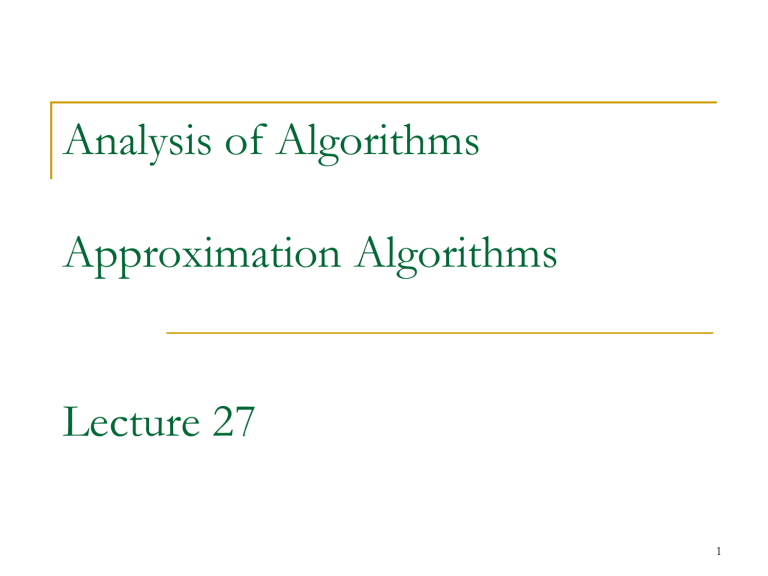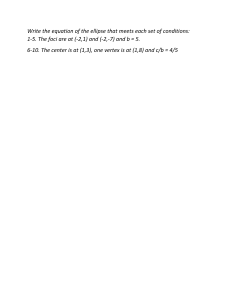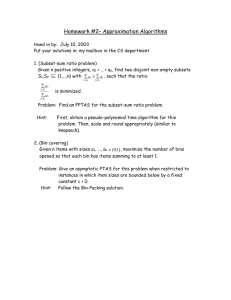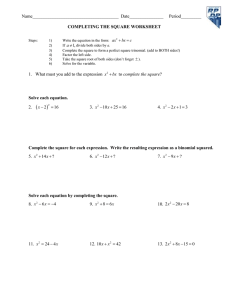
Analysis of Algorithms
Approximation Algorithms
Lecture 27
1
Topic
Computer Science response to the
phenomenon of NP-Completeness
Algorithms that approximate the solution of
NP-complete problems.
2
Vertex Cover to Dominating Set
Create a new graph such that there exists a vertex for each vertex in
G.
Furthermore, add a new vertex for each edge in 𝐺, such that there
now exists a triangle of edges.
That is to say, for an edge, 𝑒 = (𝑢,𝑣) there now exists a new vertex, 𝑧
, and the edges (𝑢,𝑣), (𝑢,𝑧), (𝑣,𝑧).
We have to prove that our graph 𝐺 has a vertex cover of size 𝑘 iff
the new graph has a dominating set of size 𝑘.
If we have a set, 𝑆, that is a vertex cover of 𝐺, then we know that the
same set is a dominating set on the new graph.
By definition of vertex cover, each edge in 𝐺 is incident to at least
one vertex in 𝑆.
Therefore, each triangle of vertices in the new graph has at least
one member of which belongs to 𝑆.
As a result, we know that each vertex in the new graph is either in 𝑆
or adjacent to 𝑆, which is the definition of a dominating set.
3
Motivation
By now we’ve seen many NP-Complete
problems.
We conjecture none of them has
polynomial time algorithm.
Unfortunately, many of the problems in NP
are of great practical use.
Motivates search for good approximation
algorithms
4
Optimization
Many of the problems we’ve encountered so
far are really optimization problems.
I.e - the task can be naturally rephrased as
finding a maximal/minimal solution.
For example: finding a maximal clique in a
graph.
5
Approximation
An algorithm that returns an answer 𝐶 which is
“close” to the optimal solution 𝐶 ∗ is called an
approximation algorithm.
“Closeness” is usually measured by the ratio
bound (𝑛) the algorithm produces.
Which is a function that satisfies, for any input
size 𝑛, max
𝐶 𝐶∗
,
𝐶∗ 𝐶
(𝑛).
6
Vertex-Cover
Instance: an undirected graph 𝐺 = (𝑉, 𝐸).
Problem: find a set 𝐶 ⊆ 𝑉 of minimal size
s.t. for any (𝑢, 𝑣) ∈ 𝐸, either 𝑢 ∈ 𝐶 or 𝑣 ∈ 𝐶.
7
Network Power
A network, with links between some components
Each link requires power supply, hence, you need to
supply power to a set of nodes that cover all links
Obviously, you’d like to connect the smallest number
of nodes
8
VC - Approximation Algorithm
C
E’ E
while E’
do let (u,v) be an arbitrary edge of E’
C C {u,v}
remove from E’ every edge
incident to either u or v.
return C.
9
Trace
10
Polynomial Time – Asymptotic Complexity
C
E’ E
O(n )
while E’ do
let (u,v) be an arbitrary edge of E’
C C {u,v}
Remove from E’ every edge incident to
either u or v
return C
2
11
Quality of Approximations
Four examples
12
Correctness and Quality
The set of vertices our algorithm returns is
clearly a vertex-cover, since we iterate
until every edge is covered
Approximation has no more than twice the
nodes in the optimal cover
13
Mass Mailing
Wish to send some message to a large
list of people (e.g. all campus)
There are some available mailing-lists,
however, the moderator of each list
charges $1 for each message sent
You’d like to find the smallest set of lists
that covers all recipients
14
Set-Cover
Instance: a finite set 𝑋 and a family 𝐹 of subsets of 𝑋,
such that
𝑋 = 𝑆∈𝐹 𝑆
Problem: to find a set 𝐶 ⊆ 𝐹 of minimal size which
covers 𝑋, i.e –
𝑋=
𝑆
𝑆∈𝐶
15
Set-Cover: Example
16
Demonstration
17
Set-Cover is NP-Hard
Proof: Observe the corresponding decision
problem.
Can reduce Vertex-Cover to set Cover?
18
VERTEX-COVER p SET-COVER
One element for
every edge
SC
VC
VC
One set for every vertex,
containing the edges it covers
19
Set Cover - A Greedy Algorithm
𝐶
𝑈 𝑋 // Make a copy of the sets
while 𝑈 do
Select 𝑆𝐹 that maximizes |𝑆 ∩ 𝑈|
𝐶 𝐶 {𝑆}
𝑈𝑈 − 𝑆
return C
We can bound the approximation by log 𝑛
There is a tight bound at ln 𝑛
20
The Trick
We’d like to compare the number of subsets
returned by the greedy algorithm to the
optimal
The optimal is unknown, however, if it
consists of 𝑘 subsets, then any part of the
universe can be covered by 𝑘 subsets!
21
Reasoning
Claim: If there is a cover of size 𝑘, then
after 𝑘 iterations the algorithm has covered
at least ½ of the elements
22
Approximating Traveling Salesman
Approx-TSP-Tour ( 𝐺, 𝑐 )
Select a vertex 𝑟 ∈ 𝐺. 𝑉 to be a “root” vertex
Computer minimum spanning tree 𝑇 for 𝐺 from 𝑟
Using Prim’s algorithm (𝐺, 𝑐, 𝑟)
Let 𝐻 be a list of vertices, ordered according to
when they are fist visited in a preorder tree walk
of 𝑇
Return the Hamiltonian cycle 𝐻
23
Approximating Traveling Salesman
Approx-TSP-Tour ( 𝐺, 𝑐 )
Select a vertex 𝑟 ∈ 𝐺. 𝑉 to be a “root” vertex
Computer minimum spanning tree 𝑇 for 𝐺 from 𝑟
Using Prim’s algorithm (𝐺, 𝑐, 𝑟)
Let 𝐻 be a list of vertices, ordered according to when they are fist
visited in a preorder tree walk of 𝑇
Return the Hamiltonian cycle 𝐻
24
Approximating Traveling Salesman
Minimum spanning tree:
In-order traversal
Visit self
Visit left-subtree
Visit right-subtree
Resulting Hamiltonian cycle:
cost 19.074
Optimal tour:
cost 14.715
25
Summary
Can sometimes find efficient
approximation algorithms for NPhard problems.
We’ve seen two such algorithms:
for VERTEX-COVER (factor of 2)
for SET-COVER (logarithmic factor).
26
Populating the NP-Completeness Universe
NP-Complete
Circuit Sat <P 3-SAT
3-SAT <P Independent Set
3-SAT <P Vertex Cover
Independent Set <P Clique
NP
3-SAT <P Hamiltonian Circuit
P
Hamiltonian Circuit <P Traveling Salesman
3-SAT <P Integer Linear Programming
3-SAT <P Graph Coloring
3-SAT <P Subset Sum
Subset Sum <P Scheduling with Release times and
deadlines
27
Open Questions
Does
every NP-hard problem
have an approximation?
And
to within which factor?
28
ְׁש ִליחָ ה
Envoi
傳送中
ְׁש ִליחָ ה
This concludes Lecture 27
There is an exercise to be submitted by the
end of the day
29







